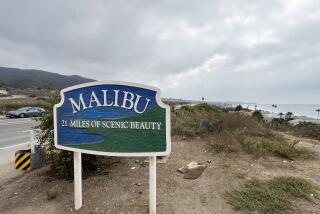Salton Sea is swarming with earthquake data
It’s one of the great mysteries of Southern California seismology: Every couple of years, the remote desert area around the Salton Sea is shaken by swarms of small to moderate earthquakes that often last several days.
The swarms returned this week, with the area recording more than 200 temblors since Saturday -- including several that were felt Wednesday. But this time, scientists had sophisticated instruments in the ground to record the activity, helping them to better understand the swarms and how they can affect seismic risk elsewhere.
Scientists have noticed that the quakes appear to have a pattern, moving southeast as the days progress. But a bigger question remains: Can the quakes trigger larger -- and potentially more destructive -- quakes along the San Andreas fault, which terminates at the shore of the Salton Sea?
A creep meter on the San Andreas just north of the Salton Sea area, operated by the University of Colorado, found a 0.002-inch slip on the fault right after the largest earthquake in the swarm -- a magnitude 4.8 on Tuesday.
Experts say that’s a tiny slip for a fault so large, but the novelty of having that kind of data is tantalizing for scientists.
“If you look at the statistics, they say the odds of something bigger happening is on the order of 1%,” said Susan Hough of the U.S. Geological Survey in Pasadena. “It raises your blood pressure as a seismologist, but we’re trying to read the tea leaves.”
Seismologists have long suspected that quakes in the Salton Sea area can trigger movement on other nearby faults, including the San Andreas. The strongest evidence of this occurred in 1987, when a magnitude 6.2 earthquake near the Salton Sea triggered a magnitude 6.6 quake 12 hours later on the Superstition Hills fault to the south.
Experts are still trying to figure out why the hard-scrabble landscape of desert expanse and small struggling towns around the sea is so seismically active.
The sea sits atop a very thin crust that is being constantly stretched as the North American and Pacific plates grind against each other. The area is also veined by dozens of fault lines that run parallel to and criss-cross one another.
The area experienced regular quake swarms until 1979, when a large temblor just south of the U.S.-Mexico border seemed to curb activity, said Doug Given, a U.S. Geological Survey scientist.
But this quiet period appears to have ended.
“Over the last few years, we seem to be returning to a more normal pattern of swarms,” he said.
Because the area is sparsely populated, it hasn’t traditionally gotten much attention from quake safety experts. But that’s changed in recent years as researchers have come to better understand how overdue the area is for a major rupture on the southern San Andreas fault and how earthquakes on one fault can trigger earthquakes on another.
In recent years, scientists have added many seismometers and other instruments to the area, said Duncan Agnew, a professor of geophysics at UC San Diego.
“There had been other things to do, like understand earthquakes in Los Angeles,” Agnew said. “This is the next thing on the list.”
The more detailed mapping now available shows this week’s swarm of earthquakes drifting about two miles southeast in three days, suggesting that a flow of hot materials under the crust could be sparking some of these swarms, said Debi Kilb, a UCSD seismologist.
Scientists believe that because of the thinness of the crust, hotter material can get closer to the surface and cause temblors. Regular seismic activity in the Mammoth Lakes area is believed to occur for the same reason, Kilb said.
“We’ve always thought that swarms have something to do with fluid migration,” Kilb said. “But we didn’t have a way to prove that. Now we have an amazing data set.”
Scientists aren’t sure what the swarms add up to or what the drift means. Stress may be relieved on some faults, but build up on others.
“Clearly [this week’s swarm] wasn’t sufficient” to trigger an event on the San Andreas, Given said. “Does it mean that a San Andreas event will happen sooner? We don’t know.”
More to Read
Sign up for Essential California
The most important California stories and recommendations in your inbox every morning.
You may occasionally receive promotional content from the Los Angeles Times.










